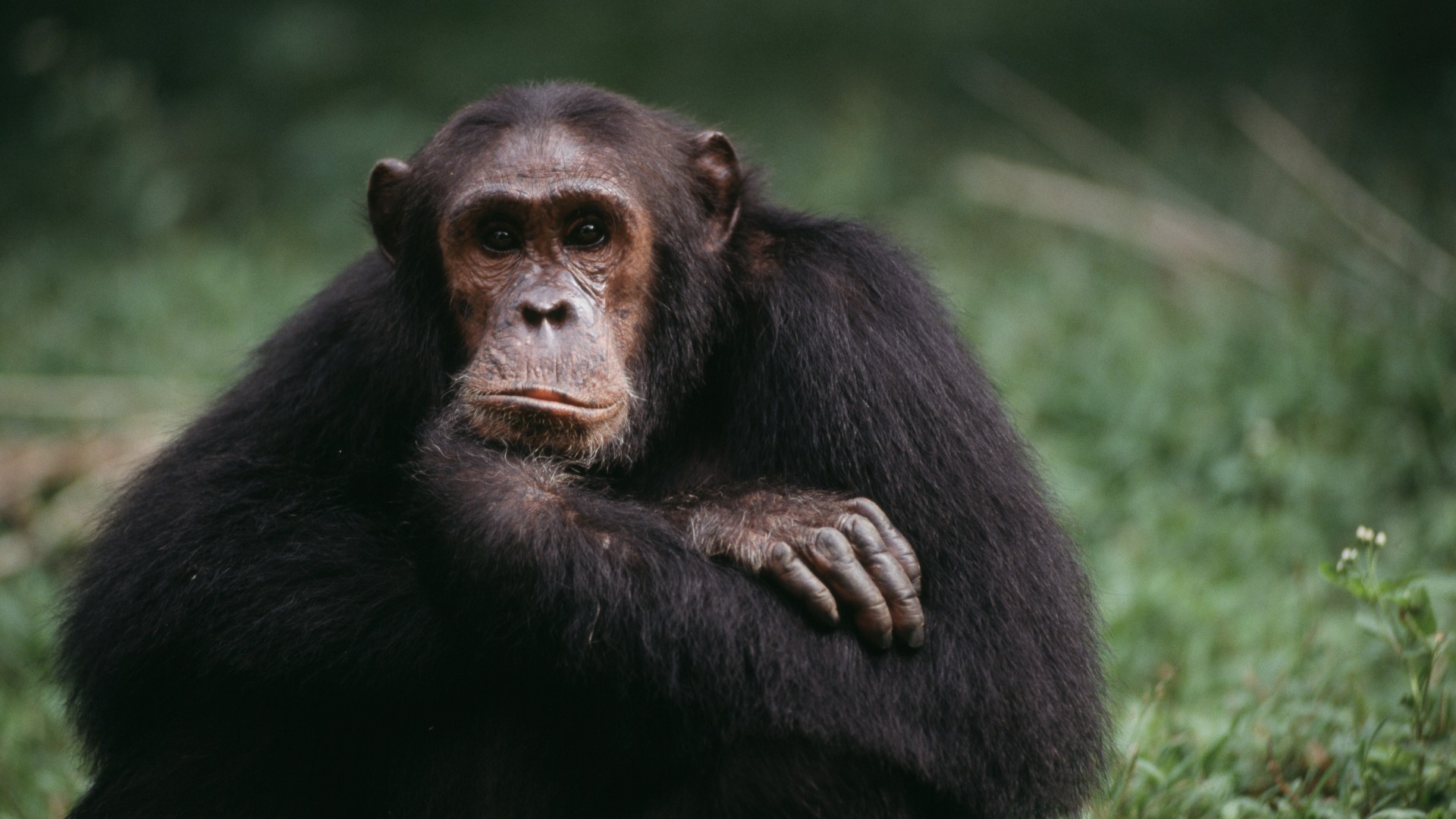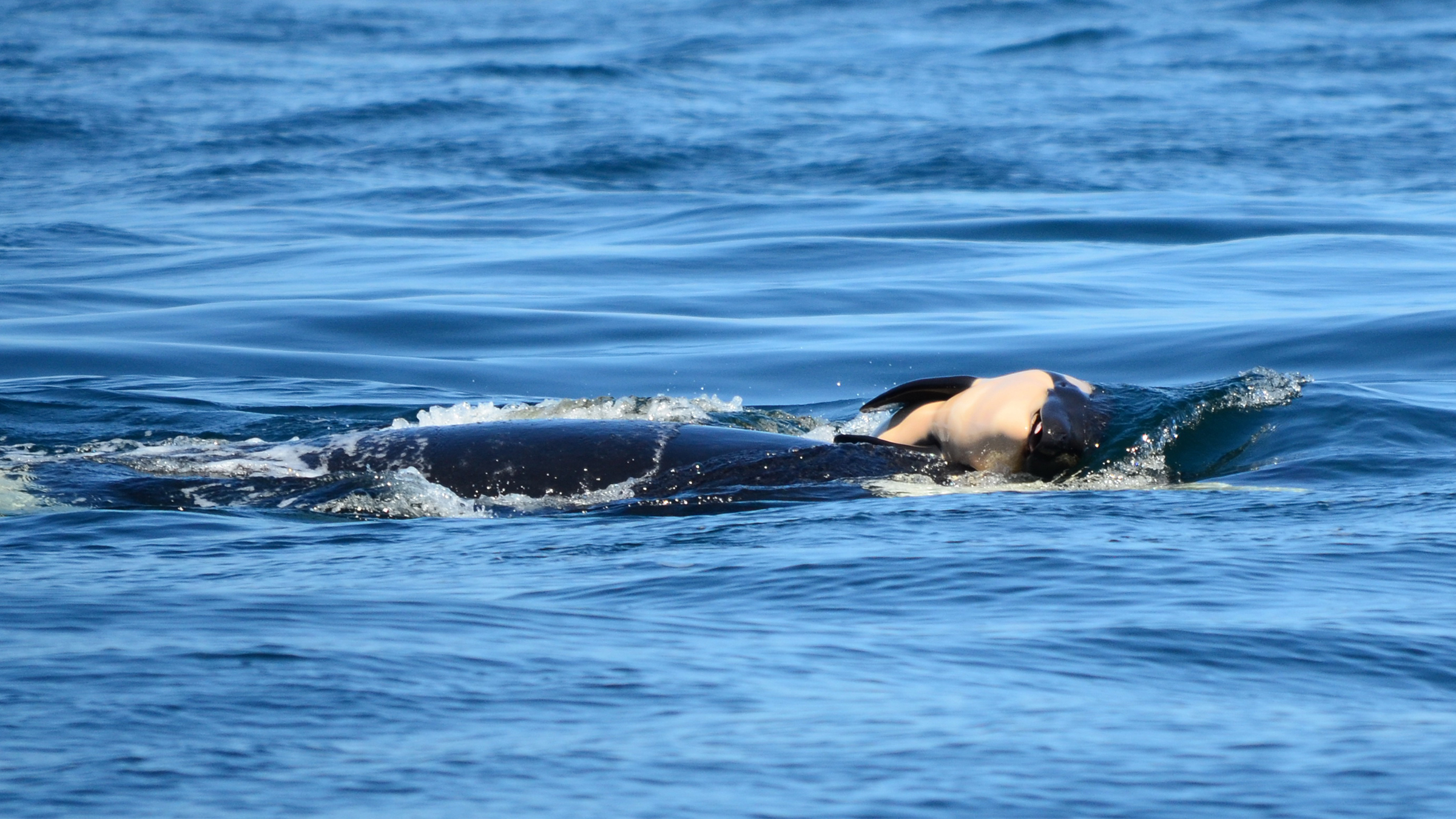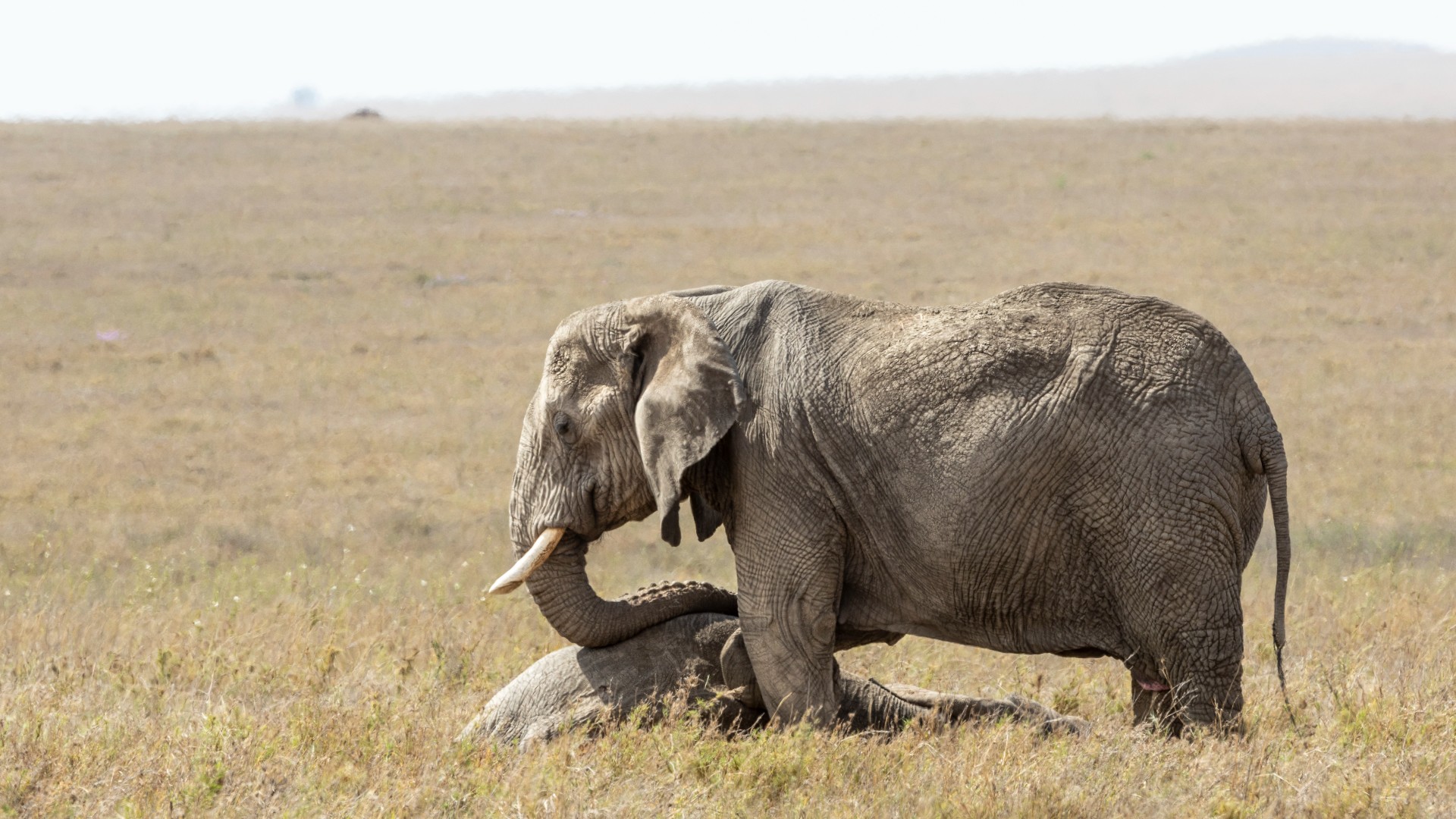
Do animals grieve?
If animals grieve, what does it mean for their welfare and conservation?

Deep in a Tanzanian rainforest in 1972, a famous aging chimpanzee matriarch called Flo breathed her last breath. For her son, Flint, it seemed to be an unbearable loss. The chimp, who was unusually bonded to his mother, suddenly grew listless, losing his appetite and becoming increasingly isolated from the rest of the troop.
"He ate seldom, and by the end of the third week had lost more than a third of his weight," wrote a young Jane Goodall: The famous primatologist had been a long-time observer of the troop. Then, one month after his mother died, Goodall reported that the emaciated Flint had died, too.
Researchers have recorded dozens of accounts of strange and heart-rending behaviors like this across the animal kingdom, when an animal's relatives or companions die. These behaviors bring up a compelling question: Do animals grieve and mourn their dead as humans do?
Death rituals
Not too long ago, this might have been dismissed as an unscientific question. But more and more researchers are exploring this idea, and their work falls into a broad field of study called "evolutionary thanatology" — the study of death and its associated rituals.
Increasingly, this field includes research on behaviors that extend beyond the human realm — such as the case of a female chimp (Pan troglodytes) in Zambia that was observed carefully using a piece of grass to clean the teeth of her recently deceased adopted son, in an almost funereal ritual, according to a 2017 study in the journal Scientific Reports. Or, the account of a Kenyan giraffe (Giraffa camelopardalis rothschildi) that stood vigil over the body of her dead calf even after it had been ravaged by hyenas.
Related: Which animals sing?
Similarly, in 2018 many were transfixed by the story of a female orca (Orcinus orca) in the Salish Sea off the coast of Canada and Washington that spent 17 days tirelessly pushing along her lifeless calf, traversing 1,000 miles (1,600 kilometers) with the body before finally letting it go.
Sign up for the Live Science daily newsletter now
Get the world’s most fascinating discoveries delivered straight to your inbox.

It's not just wild animals that display this kind of behavior, but domesticated ones too: Stefania Uccheddu, a veterinarian and researcher at the San Marco Veterinary Clinic and Laboratory in Italy, remembered a case a few years ago when a dog came into her practice for treatment because he refused to eat. "My colleagues took blood samples, they checked the heart — everything was okay. There was no reason to explain why the dog did not eat any more," Uccheddu told Live Science. "The only difference is that his brother had died one week ago."
This event kick-started Uccheddu's investigation into death-related behaviors in dogs, which resulted in the first study to document a spate of grief-like behaviors in these animals when their canine companions died — including sleeping more, as well as eating and playing less.
Back in the wild, elephants show some of the most widely documented and striking behaviors around death. African elephants (Loxodonta africana) have been known to tote around the jawbones of their deceased relatives, and to gather in silence for long periods over corpses, almost completely still with their heads dipped downward, and their heavy trunks resting on the ground.
Asian elephants (Elephas maximus) show behaviors that seem similarly mournful. In 2013, elephant biologist Sanjeeta Pokharel found a dead Asian elephant on a riverbank in India, in a spot that was devoid of vegetation. Despite this, the body was mysteriously surrounded by "lots of branches, trees, leaves and everything. That indicates that they might have been brought there," Pokharel told Live Science, who is based at Kyoto University, Japan, and who later described the event in a 2019 study in the journal Primates. She also recounted that two females trekked to the site and walked around the body almost ceremoniously. The somewhat ritualistic scenario reminded her of "a funeral ceremony that happens in Hindu culture where [people] go around the carcass," Pokharel said. "It was exactly like that."
In 2022, she and her co-researcher and husband Nachiketh Sharma, an elephant biologist also based at Kyoto University, published a study in the journal Royal Society Open Science chronicling several death-related behaviors in Asian elephants, crowdsourced from YouTube videos — which including one rarely observed behavior of females doggedly carrying around their dead newborns, draped over their trunks and tusks, for days at a time.
Related: What's the chattiest animal?
"Many times, we also got emotional [watching this]," Pohkarel said. In this scenario, "as a human, you can clearly see some kind of grief. [But] I don't know whether we can call it grief right now."
She described the difficulty at the heart of such research: Researchers lack definitive scientific proof of what these animals are going through, and so there is a risk of anthropomorphizing animals if scientists label it "grief." But by the same token, if researchers don't recognize things that can't be measured, do they risk overlooking a potential wealth of animal emotion?
What, then, should we call it when a captive dolphin who's lost its companion sinks to the bottom of the pool, sitting there for long stretches and coming to the surface only to breathe? Or the wailing sound a sea lion makes when it loses its young?
Deciphering "grief"
Trying to define these behaviors opens up a can of worms. One school of thought is that in order to grieve, an individual must first be able to understand the concept of death and their relationship with this inevitable force — something that's difficult to prove in animals. (Although, there are some compelling cases that animals do conceptualize death.)
However, a grasp of death may not be necessary for an individual to feel grief. Another way of seeing grief is as part of the process of trying to understand a loss — and therefore observable in how an individual responds to a lifeless corpse.
It's also true that these behaviors could be ascribed to many other things: curiosity, confusion, stress or fear. This is especially the case in species where the death-response is a little more bizarre.
Take crows as an example. Death-related behaviors are most frequently recorded in social mammals that form strong bonds with one another, but these birds are a notable exception with their famous "crow funerals." During these events, crows (Corvus brachyrhynchos) gather around the bodies of dead crows in rowdy displays — cawing while examining corpses, and sometimes also attacking and even trying to mate with them. Some researchers suggest that a relative's death may provide an opportunity for these birds to familiarize themselves with the concepts of risk and threat, and to learn about their vulnerabilities from this experience.

Meanwhile, elephants have been observed burying their dead in mud, or covering them with branches and leaves, Sharma said — which, rather than a symbol of mourning, could be a practical attempt to stop a corpse from attracting predators. Similarly, elephants that gather round a corpse seem to be in mourning, but they also sniff and touch the body — so what if instead of pondering their loss, they're simply investigating the cause of death?
"We can't say whether the elephants are actually curious, or grieving," Sharma said. "It's very difficult to decipher."
Related: Do elephant tusks or rhino horns ever grow back?
How to think about animal grief
Even in humans there's no rulebook for what grief looks like; it manifests in a large and wide-ranging spectrum of behaviors and emotions. So who's to say that curiosity, fear and learning aren't steps in that process for animals, too?
These jumbled and conflicting views are perhaps what prompted anthropologist Barbara J. King to draw up her own definition of animal grief. The prominent scientist, who wrote a book titled "How Animals Grieve" (University of Chicago Press, 2013), explained that we can define grief by a change in essential functions — a departure from the usual pattern of eating, sleeping and socializing — that is triggered by death. This would widen the net of grief to include dozens of animal species that experience this emotion, King argued.
Some researchers support the idea that grief is valuable for survival, which could also strengthen the case that it occurs in animals. For example, baboons (Papio hamadryas ursinus) that become listless after a relative's death receive increased rates of grooming by other members of the troop, observational research shows.
"Probably this kind of reduction of activity is a way to save energy, attract the attention of your companions, and at the same time create a new network" to replace the one the animal's lost, Uccheddu said. It's not dissimilar to our human world, where communities come together to feed and care for grieving people after a death, she pointed out.
Meanwhile, more data may eventually bring us closer to understanding what an animal experiences when another one dies. For example, facial recognition technologies are helping researchers track dogs' reactions to life events, Uccheddu explained. Measuring potential shifts in key hormones like oxytocin (thought to play a role in social bonding) could also give us a more precise read on an animal's internal state after it experiences a companion's death, Pokharel added.
Nevertheless, the question of animal grief is up against a gaping dearth of research on animal cognition and emotion, with complex questions to answer if scientists are ever to definitively prove that animals feel grief. Unless researchers find a way to talk to other species, there's unlikely to be any way to objectively know what they feel. As Sharma said, "only an elephant can say that it's grieving."
Perhaps, though, the ultimate question should be less about whether animal grief exists, and more about how powerful it could be if we acted as though it did.
Assuming that animals feel attachment to their companions and experience grief-like emotions when they die could have huge welfare implications. It could make us more sensitive to our pets, and help us take better care of animals in zoos. It could also encourage people to care more about humanity's impact on the planet — whether that's poaching, habitat destruction, pollution or climate change — and make a better case for protecting it, for the species we share it with.
"When we talk about conservation, at least some kind of emotion should be there," Pokharel said. What better way to accomplish that, than to believe that our fellow animals feel it, too?
Originally published on Live Science.

Emma Bryce is a London-based freelance journalist who writes primarily about the environment, conservation and climate change. She has written for The Guardian, Wired Magazine, TED Ed, Anthropocene, China Dialogue, and Yale e360 among others, and has masters degree in science, health, and environmental reporting from New York University. Emma has been awarded reporting grants from the European Journalism Centre, and in 2016 received an International Reporting Project fellowship to attend the COP22 climate conference in Morocco.










